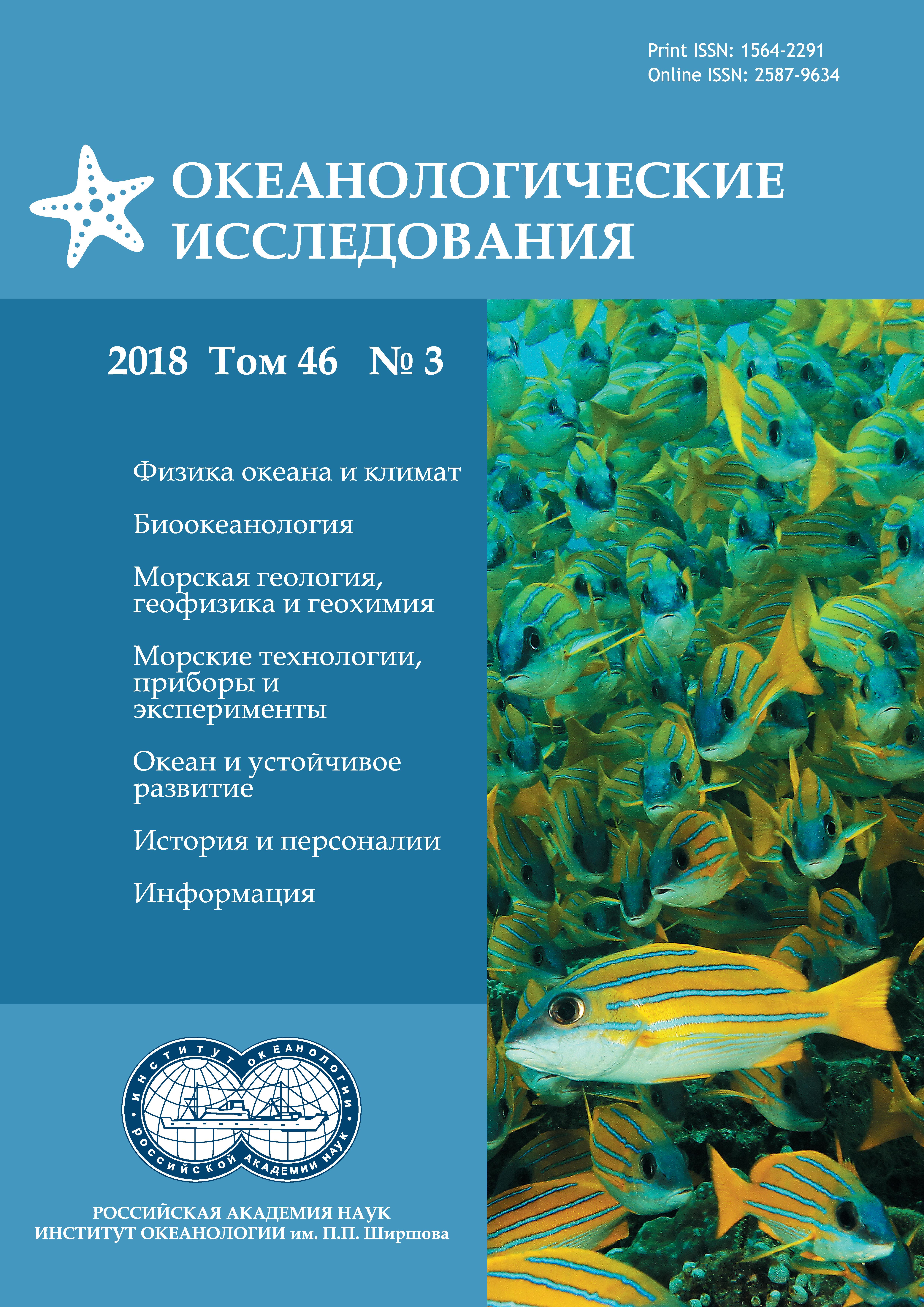ОКЕАНИЧЕСКИЙ ФАКТОР МУЛЬТИДЕКАДНОЙ ИЗМЕНЧИВОСТИ СОВРЕМЕННОГО КЛИМАТА И ПЕРСПЕКТИВЫ ЕЕ МОНИТОРИНГА
Аннотация
Мультидекадная изменчивость современного климата (колебания 50-70 лет) - одна из наиболее актуальных текущих проблем в науках о Земле. Собственно колебание состоит из двух фаз, каждая из которых составляет 25-35 лет: фазы, когда верхний деятельный слой (ВДС) Мирового океана, отдавая явное и скрытое тепло в атмосферу, совершает своеобразную его тепловую разгрузку, а также фазы более континентального климата, когда ВДС океана аккумулирует тепло, стремясь восстановить свое начальное состояние. Есть основание полагать, что рассматриваемая изменчивость отражает внутреннюю динамику климатической системы океан-атмосфера-континент. Присутствие планетарных структур в атмосфере ГАО (глобальной атмосферной осцилляции) и в океане МОСТОК (мультидекадной осцилляции теплосодержания океана) позволяет понять воспроизведение наблюдаемой ритмики климатической системы. Наиболее чувствительными для климатической системы являются смены фаз климата, в результате которых в ней происходят как бы внезапные качественные сдвиги, сопровождаемые определенной перестройкой общей циркуляции океана и атмосферы. Так в океане при смене фазы климата либо интенсифицируется глубокая конвекция (при тепловой разгрузке ВДС океана), либо она ослабевает, а возможно и прекращается (при аккумуляции тепла ВДС). В атмосфере смены фаз климата отражаются на муссонной циркуляции: более континентальной фазе климата соответствует усиление муссонной циркуляции со всеми сопровождающими этот процесс особенностями. Прогноз смен фаз климата приобретает в связи с этим важное значение для экономической, социальной и политической жизни общества. В свою очередь качество прогноза связано с пониманием природы наблюдаемой изменчивости и представлением механизма этого явления. В работе для отдельных районов Мирового океана сопоставлены эволюция термической структуры ВДС с динамикой стерической моды колебаний уровня, определенной по спутниковым альтиметрическим наблюдениям. Установлено, что повышение уровня океана между временными фазами 1993-1999 гг. и 2000-2015 гг. составило 4-6 см и соответствовало тому росту уровня, который должен был бы произойти при наблюдаемых увеличениях теплосодержания ВДС океана. Сделан вывод о том, что на междекадных временных масштабах наряду с данными температуры поверхности океана (ТПО) в перспективе могут быть использованы альтиметрические спутниковые наблюдения для выявления региональных источников и стоков тепла в океане.
Литература
- Анисимов М.В., Бышев В.И., Залесный В.Б., Мошонкин С.Н. Мультидекадная изменчивость термической структуры вод Северной Атлантики и ее климатическая значимость // Доклады РАН. 2012. Т 443. № 3. C. 372–376.
- Белоненко Т.В., КолдуновВ.В., Старицин Д.К., ФуксВ.Р., ШиловИ.О. Изменчивость уровня северо-западной части Тихого океана. СПб.: Изд-во «СМИО Пресс», 2009. 309 с.
- Бышев В.И., Копрова Л.Н., Навроцкая С.Е., Позднякова Т.Г., Романов Ю.А. Аномальное состояние Ньюфаундлендской энергоактивной зоны в 1990 г. // Доклады АН СССР. 1993. Т 331. № 6. С. 735–738.
- Бышев В.И. Синоптическая и крупномасштабная изменчивость океана и атмосферы. М.: Наука, 2003. 343 с.
- Бышев В.И., Нейман В.Г., Романов Ю.А., Серых И.В. О фазовой изменчивости некоторых характеристик современного климата в регионе Северной Атлантики // Доклады Академии наук. 2011. Т 438. № 6. С. 817–822.
- Бышев В.И., Нейман В.Г., Романов Ю.А., Серых И.В. Эль-Ниньо как следствие Глобальной атмосферной осцилляции в динамике климатической системы Земли // Доклады Академии наук. 2012. Т. 446. № 1. С. 89–94.
- Бышев В.И., Снопков В.Г. О формировании поля температуры воды поверхности океана в энергоактивной зоне северо-западной части Тихого океана на примере полигона «МЕГАПОЛИГОН» // Метеорология и гидрология. 1990. № 11. C. 70–77.
- Бышев В.И., Фигуркин А.Л., Анисимов И.М. Междекадная изменчивость термической структуры вод верхнего деятельного слоя на северо-западе Тихого океана // Доклады Академии наук. 2017. Т. 477. № 2. С. 240–244.
- Бышев В.Н., Нейман В.Г., Романов Ю.А., Серых И.В. О пространственной неоднородности некоторых параметров глобальной изменчивости современного климата // Доклады Академии наук. 2009. Т. 426. № 4. С. 543–548.
- Гусев А.В., Дианский Н.А. Воспроизведение циркуляции Мирового океана и ее климатической изменчивости в 1948–2007 гг. с помощью модели INMOM // Изв. РАН Физика атмосферы и океана. 2014. Т. 50. № 1. С. 3–15.
- Зверева А.Е. Низкочастотные волновые движения в Японском море: Дисс. на соиск. уч. ст. канд. геогр. наук: 25.00.28. СПб., 2017. 310 с.
- Лебедев С.А., Костяной А.Г. Спутниковая альтиметрия Каспийского моря. М.: Издательский центр «Море» Международного института океана, 2005. 366 с.
- Мошонкин С.Н., Дианский Н.А., Эйдинов Д.А., Багно А.В. Модель циркуляции Северной Атлантики и Северного Ледовитого океана // Океанология. 2004. Т. 44. № 6. C. 811–825.
- Пономарев В.И., Дмитриева Е.В., Шкорба С.П., Карнаухов А.А. Изменение планетарного климатического режима на рубеже XX-XXI веков // Вестник МГТУ. 2018. Т. 21. № 1. С. 160–169. DOI: 10.21443/1560-9278-2018-21-1-160-169.
- Троицкая Ю.И., Рыбушкина Г.В., Соустова И.А., Баландина Г.Н., Лебедев С.А., Костяной А.Г., Панютин А.А., Филина Л.В. Спутниковая альтиметрия внутренних водоемов // Водные ресурсы. 2012. Т 39. № 2. С. 169–185.
- Фукс В.Р. Уровень Мирового океана как индикатор глобального потепления // География и современность: Сб. СПбГУ 2005. Вып. 10. С. 73–93.
- Bond N. A., Overland J.E., Spillane M., Stabeno P. Recent shifts in the state of the North Pacific // Geophysical Research. Letters. 2003. Vol. 30. No. 23. P. 21–83. D0I:10.1029/2003GL018597.
- Byshev V.I., Neiman V.G., Anisimov M.V., Gusev A.V., Serykh I.V., Sidorova A.N., Figurkin A.L., Anisimov I.M. Multi-decadal oscillations of the ocean active upper-layer heat content // Pure and Applied Geophysics. 2017. Vol. 174. No. 7. P. 2863–2878. DOI: 10.1007/s00024-017-1557-3.
- Chen J.L., Pekker T., Wilson C.R., Tarley B.D., Kostianoy A.G., Cretaux J.F, Safarov E.S. Long-term Caspian Sea level change // Geophys. Res. Lett. 2017. Vol. 44. P. 6993-7001. DOI: 10.1002/2017GL073958.
- Chu P.C. Global upper ocean heat content and climate variability // Ocean Dynamics. 2011. DOI: 10.1007/s10236-011-0411-x.
- De Viron O., Dickey J.O., Ghil M. Global modes of climate variability // Geophyscal Research Letters. 2013. Vol. 40. P. 1832–1837. DOI:10.1002/grl.50386.
- Gill A.E., Niiler P.P. The theory of the seasonal variability in the ocean // Deep-Sea Reseach. 1973. Vol. 20. P. 141–177.
- IPCC, 2013, Climate Change: The Physical Science Basis. Contribution of Working Group I to the Fifth Assessment Report of the Intergovernmental Panel on Climate Change (ed. Stocker, T.F. et al.). Cambridge University Press. Cambridge. UK and New York. NY. USA.
- Large W.G., Yager S.G. Diurnal to decadal global forcing for ocean and sea-ice models: the data sets and flux climatologies // Climate and Global Dynamics Division. National Center for Atmospheric Research. Boulder. Colorado. 2004. 105 p.
- Lee T., McPhaden M.J. Decadal phase change in large-scale sea level and winds in the Indo- Pacific region at the end of the 20-th Century // Geophysical Research Letters. 2008. Vol. 35. L01605. DOI: 10.1029/2007 GL032419j.
- Levitus S., Antonov J.I., Boyer T.P., Locamini R.A., Garcia H.E. Global ocean heat content 1955-2008 in light of recently revealed instrumentation problems // Geophyscal Research Letters. 2009. Vol. 36. L07608. DOI: 10.1029/2008 GL037155.
- Liman J.M., GoodS.A., Gouretski V.V. Robust warming ofthe global upper ocean // Nature. 2010. Vol. 465. DOI: 10.1038/nature09043.
- Mao K., Chen J., LI Z., Ma Y., Song Y., Tan X., Yang K. Global Water Vapor Content Decreases from 2003 to 2012: An Analysis Based on MODIS Data // Chin.Geogra. Sci. 2017. Vol. 27. No. 1. P. 1–7. DOI: 10.1007/s11769-017-0841-6.
- Minobe S.A. 50-70-year climatic oscillation over the North Pacific and North America // Geophyscal Research Letters. 1997. Vol. 24. P. 683–686.
- Steinman B.A., Mann M.E., Miller S.K. Atlantic and Pacific multidecadal oscillations and Northern Hemisphere temperature // Science. 2013. Vol. 347. P. 988–991. DOI: 10.1126/ science.1257856.
- Tsonis A.A., Swanson K., Kravtsov S.A. New dynamical mechanism for major climate shifts // Geophysical Research Letters. 2007. Vol. 34. L13705. DOI:10.1029/2007 GL030288.
Передача авторских прав происходит на основании лицензионного договора между Автором и Федеральным государственным бюджетным учреждением науки Институт океанологии им. П.П. Ширшова Российской академии наук (ИО РАН)












